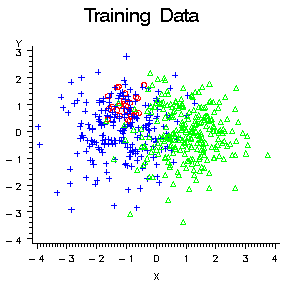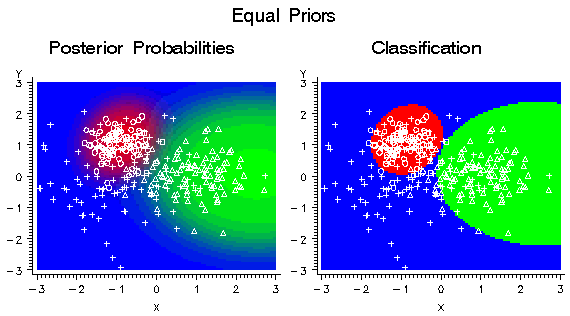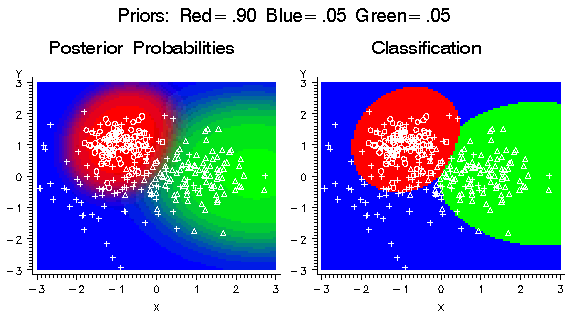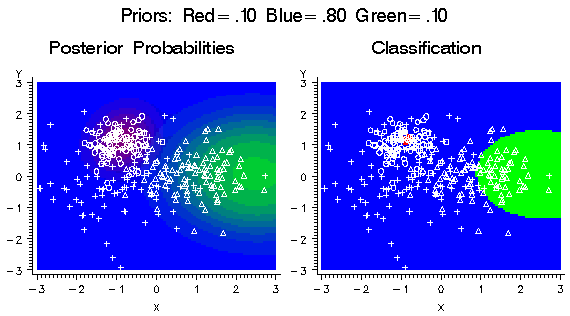Prior Probabilities
For a categorical target
variable, each modeling node can estimate posterior probabilities
for each class, which are defined as the conditional probabilities
of the classes given the input variables. By default, the posterior
probabilities are based on implicit prior probabilities that are proportional
to the frequencies of the classes in the training set. You can specify
different prior probabilities via the Target Profile using the Prior
Probabilities tab (see the Target Profile chapter).
Also, given a previously scored data set containing posterior probabilities,
you can compute new posterior probabilities for different priors by
using the DECIDE procedure, which reads the prior probabilities from
a decision data set.
Prior probabilities
should be specified when the sample proportions of the classes in
the training set differ substantially from the proportions in the
operational data to be scored, either through sampling variation or
deliberate bias. For example, when the purpose of the analysis is
to detect a rare class, it is a common practice to use a training
set in which the rare class is over represented. If no prior probabilities
are used, the estimated posterior probabilities for the rare class
will be too high. If you specify correct priors, the posterior probabilities
will be correctly adjusted no matter what the proportions in the training
set are. For more information, see Detecting Rare Classes.
Increasing the prior
probability of a class increases the posterior probability of the
class, moving the classification boundary for that class so that more
cases are classified into the class. Changing the prior will have
a more noticeable effect if the original posterior is near 0.5 than
if it is near zero or one.
For linear logistic
regression and linear normal-theory discriminant analysis, classification
boundaries are hyperplanes; increasing the prior for a class moves
the hyperplanes for that class farther from the class mean, while
decreasing the prior moves the hyperplanes closer to the class mean.
But changing the priors does not change the angles of the hyperplanes.
For quadratic logistic
regression and quadratic normal-theory discriminant analysis, classification
boundaries are quadratic hypersurfaces; increasing the prior for a
class moves the boundaries for that class farther from the class mean,
while decreasing the prior moves the boundaries closer to the class
mean. But changing the priors does not change the shapes of the quadratic
surfaces.
To show the effect of
changing prior probabilities, the data in the following figure were
generated to have three classes, shown as red circles, blue crosses,
and green triangles. Each class has 100 training cases with a bivariate
normal distribution.
These training data
were used to fit a quadratic logistic regression model using the Neural
Network engine. Since each class has the same number of training cases,
the implicit prior probabilities are equal. In the following figure,
the plot on the left shows color-coded posterior probabilities for
each class. Bright red areas have a posterior probability near 1.0
for the red circle class, bright blue areas have a posterior probability
near 1.0 for the blue cross class, and bright green areas have a posterior
probability near 1.0 for the green triangle class. The plot on the
right shows the classification results as red, blue, and green regions.
If the prior probability
for the red class is increased, the red areas in the plots expand
in size as shown in the following figure. The red class has a small
variance, so the effect is not widespread. Since the priors for the
blue and green classes are still equal, the boundary between blue
and green has not changed.
If the prior probability
for the blue class is increased, the blue areas in the plots expand
in size as shown in the following figure. The blue class has a large
variance and has a substantial density extending beyond the high-density
red region, so increasing the blue prior causes the red areas to contract
dramatically.
If the prior probability
for the green class is increased, the green areas in the plots expand
as shown in the following figure.
In the literature on
data mining, statistics, pattern recognition, and so on, prior probabilities
are used for a variety of purposes that are sometimes confusing. In
Enterprise Miner, however, the nodes are designed to use prior probabilities
in a simple, unambiguous way:
If you do not explicitly
specify prior probabilities (or if you specify None for prior probabilities
in the target profile), no adjustments for priors are performed by
any nodes.
For classification,
each case i is assigned to the class with the greatest posterior probability,
that is, the class t for which Post(i,t) is maximized.
Prior probabilities
have no effect on estimating parameters in the Regression node, on
learning weights in the Neural Network node, or, by default, on growing
trees in the Tree node. Prior probabilities do affect classification
and decision processing for each case. Hence, if you specify the appropriate
options for each node, prior probabilities can affect the choice of
models in the Regression node, early stopping in the Neural Network
node, and pruning in the Tree node.
Prior probabilities
are also used to adjust the relative contribution of each class when
computing the total and average profit and loss as described in the
section below on Decisions. The adjustment of total
and average profit and loss is distinct from the adjustment of posterior
probabilities. The latter is used to obtain correct posteriors for
individual cases, whereas the former is used to obtain correct summary
statistics for the sample. The adjustment of total and average profit
and loss is done only if you explicitly specify prior probabilities;
the adjustment is not done when the implicit priors based on the training
set proportions are used.
Note that the fit statistics
such as misclassification rate and mean squared error are not adjusted
for prior probabilities. These fit statistics are intended to provide
information about the training process under the assumption that you
have provided an appropriate training set with appropriate frequencies.
Hence, adjustment for prior probabilities could present a misleading
picture of the training results. The profit and loss summary statistics
are intended to be used for model selection, and to assess decisions
that are made using the model under the assumption that you have provided
the appropriate prior probabilities and decision values. Therefore,
adjustment for prior probabilities is required for data sets that
lack representative class proportions. For more details, see Decisions.
If you specify priors
explicitly, Enterprise Miner assumes that the priors that you specify
represent the true operational prior probabilities and adjusts the
profit and loss summary statistics accordingly. Therefore:
-
You can use training sets based on different sampling methods or with differently weighted classes (using a frequency variable), and as long as you use the same explicitly specified prior probabilities, the profit and loss summary statistics for the training, validation, and test sets will be comparable across all of those different training conditions.
If you do not specify
priors, Enterprise Miner assumes that the validation and test sets
are representative of the operational data. Hence, the profit and
loss summary statistics are not adjusted for the implicit priors based
on the training set proportions. Therefore:
-
If the validation and test sets are indeed representative of the operational data, then regardless of whether you specify priors, you can use training sets based on different sampling methods or with differently weighted classes (using a frequency variable), and the profit and loss summary statistics for the validation and test sets will be comparable across all of those different training conditions.
If a class has both
an old prior and a new prior of zero, then it is omitted from the
computations. If a class has a zero old prior, you might not assign
it a positive new prior, since that would cause a division by zero.
Prior probabilities might not be missing or negative. They must sum
to a positive value. If the priors do not sum to one, they are automatically
adjusted to do so by dividing each prior by the sum of the priors.
A class might have a zero prior probability, but if you use PROC DECIDE
to update posterior probabilities, any case having a nonzero posterior
corresponding to a zero prior will cause the results for that case
to be set to missing values.





![Post(i, t) = [OldPost(i,t)*Prior(t) / OldPrior(t)]/ sum over j of [OldPost(i,j)*Prior(j) / OldPrior(j)]](images/prede88.png)